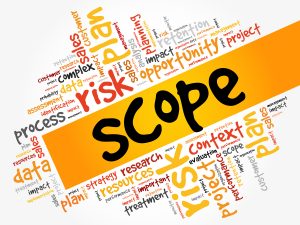Good Scope of Work Statements Establish Boundaries and Responsibilities
A well-defined and communicated scope statement is one of the primary methods of managing a client’s often-changing expectations of what they will ultimately receive from a project. This is developed during the proposal phase of the project — initiated as part of the sales cycle — and is included within the more comprehensive scope of work document.
There are really two types of scope of work statements, each serving a different purpose in clarifying the scope and expectations of a project and its deliverables.
The first is a product or deliverable scope statement; the second is a project scope statement.
The deliverable and project scope statements should be developed in conjunction with the site-survey process (which is a must) and verified during the subsequent field-verification audit process.
Both of these are opportune times to visually communicate to clients what will and what will not be delivered by the AV integrator, as well as and who will and who will not be responsible for specified activities within the implementation effort.
In my experience, deliverable scope statements often look like a bill of materials, or a listing of numerous pieces of equipment (projectors, speakers, microphones, lectern, control panels, etc.) and supporting infrastructure (cabling, switchers, connectors, etc.). This list — although often inclusive of all of the equipment and parts to be delivered (minus some incidentals) — is usually the only section that the client reviews. As such, it leaves the impression and creates the expectation that all the equipment and ancillary materials will be included in order to make the project’s system implementation successful.
Unfortunately, this initial impression often causes conflict later in the project, for instance, when the AV integrator is waiting on ownerfurnished equipment (OFE) to arrive (or to be found or tested), or when another contractor must provide other pieces of equipment (security cameras, lecterns, etc.). The deliverable scope statement lists what the AV integrator will and will not deliver, because
Delineating what the integrator is not responsible for can be as important as listing what the integrator is responsible for.
This listing helps alleviate any misunderstandings and ultimately establishes boundaries for each party’s responsibilities.
In the same way, the project scope statement lists what activities the AV integrator will perform and what activities the AV integrator will not perform during the delivery and implementation process. As in the case of the deliverable statement, the “out of scope” column is often more important than the “in scope” column because it clearly marks the project’s boundaries and helps head off the dreaded “scope creep.” Integrators know scope creep when they hear it. It usually results when a client says something like, “I thought that was included” or “I assumed you were going to do that.” In the ideal world, with clearly written scope statements, no client should ever utter such words. Make Scope Statements Stand Out
Both scope statements — deliverable and projects statements — should be within of the overall scope of work. It helps to break them out as tables, with one column detailing what’s considered in scope, and a second column listing what’s out of scope.
For the deliverable scope statement, the in-scope column would include the bill of materials and any other products the integrator agrees to provide. The out-of-scope column might include electrical systems, HVAC-related products, owner-furnished equipment, cabling to and from owner-furnished equipment, structural materials, paints, finishes, etc. If you want to be as detailed as possible, add columns to the deliverable scope statement to clearly show who is responsible for what, including the AV integrator, the client, the general contractor, and others.
Approach the creation of the project scope statement the same way, with a pair of columns that spell out what activities are in scope and what activities are out of scope. The project scope statement is a list of the key activities which must occur for the implementation and commissioning of the AV system to be successful.
Areas of contention typically have to do with owner-furnished subcontractors, therefore clearly delineating boundaries and responsibilities can eliminate finger-pointing later on (who is doing what to whom, for example, and what “complete” means to each subcontractor).
Other areas that often cause scope creep include: user training (how many classes and how many reschedules / make-ups); user testing and commissioning (how many people to include and how many test scenarios); site cleanup (especially the mess other contractors leave behind); and the transition to a client service department (when is done really done?).
The project scope statement can also be used as a responsibility listing, with additional columns used for different trades or contractors.
Using these visual aids during the sales process provides an opportunity to negotiate and show the client that the AV integrator has a comprehensive understanding of the deliverables and project activities and is intent on preventing future misunderstandings.
Using the scope statements as part of the client kick-off meeting helps clearly delineate responsibilities before the actual implementation and integration work has started, dramatically reducing the probability of finger-pointing and misaligned expectations.
And the scope of work statements help reduce the chance of scope creep. The AV integrator’s typical reaction to scope creep is, “We hadn’t planned on doing that, but I guess we’ll have to.” There’s nothing wrong with taking on extra work, but this decision is a business decision, not a project manager’s decision. Scope creep has the potential to affect the company’s performance and ultimate profitability — clearly a business decision.
Clearly delineated scope statements allow more opportunity for justifiable change requests, which the integrator can charge for or not, depending on their strategy. And they enhance the integrator’s ability, through their sales representatives and project managers, to continually clarify and align expectations and responsibilities.
Stayed tuned for Part 2 of this blog series, when we outline what a comprhensive scope of work looks like.
by Brad Malone, MA, PMP
Partner, Navigate Management Consulting
Join Navigate Academy, the new online learning platform, designed for systems integrators and related technology companies.
Solutions360 is a proud sponsor of Navigate Academy’s upcoming webinar
Essential Roles within a Project
with Brad Malone
Friday, June 5 @ 11:00am CDT
Handpicked Related Content: Forecasting for Successful Project Management



